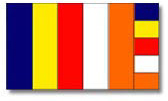The Buddhist flag is a modern creation jointly designed by Mr J.R. de Silva and Colonel Henry S. Olcott to mark the revival of Buddhism in Ceylon in 1880. It was accepted as the International Buddhist Flag by the 1952 World Buddhist Congress.
Colonel Olcott designed a flag from the six colours of the aura that he believed shone around the head of the Buddha after His Enlightenment.
The colonel’s flag later came to symbolize the unity of Buddhists. Thereafter, it has been used worldwide and has been used in nearly 60 countries during Buddhist festive seasons, particularly during the Vesak celebrations.
Colonel Olcott was one of the greatest American Buddhists who dedicated his later life entirely to the people of Asia. He is known as the father of the Buddhist education movement since he initiated the establishment of close to 400 Buddhist schools and colleges in Sri Lanka.
|
International Buddhist Flag

The six colours represent the colors of the aura that emanated from the body of the Buddha when He attained Enlightenment under the Bodhi Tree.
|
|
Blue
|
The spirit of Universal Compassion for all beings, the concept of loving kindness and peace in Buddhism.
|
|
Yellow
|
The Middle Way which avoids all extremes and brings balance and liberation.
|
|
Red
|
The Blessings that the practice of the Buddha’s Teaching brings. |
|
White
|
The Purity of the Buddha’s Teaching and the Liberation it brings. |
|
Orange
|
The unshakable Wisdom of the Buddha’s Teaching.
|
| |
|
|
|
|
Regardless of race, nationality, division or colour, all sentient beings possess the potential of Buddhahood. |
|



